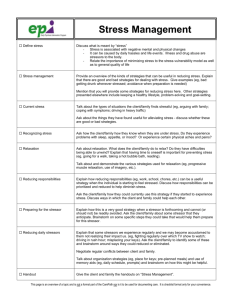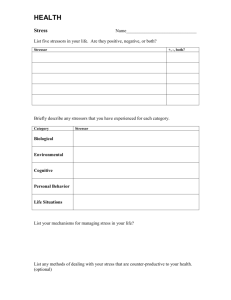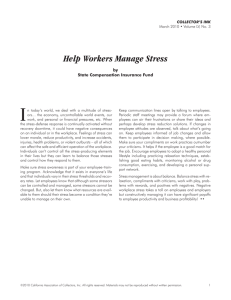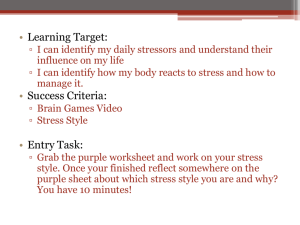Stress
advertisement
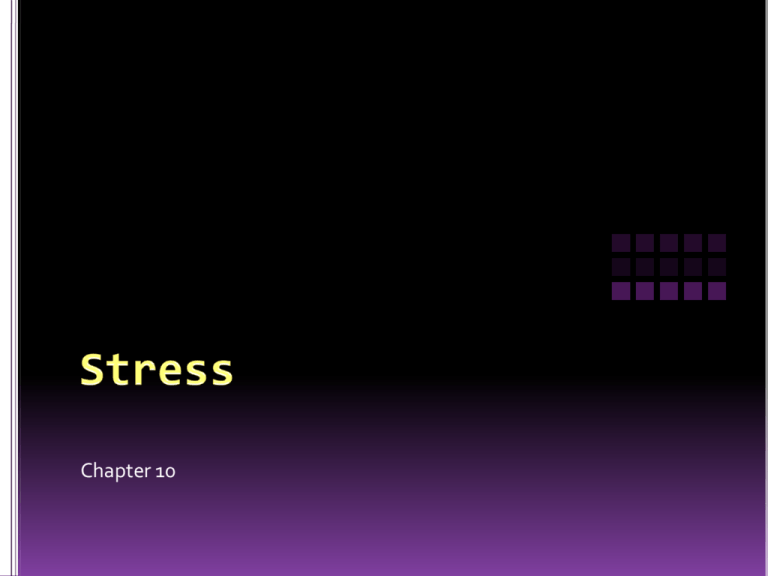
Chapter 10 Stressor = any physical or psychological event or condition that produces stress Stress response = the physiological changes associated with stress Stress = the collective physiological and emotional responses to any stimulus that disturbs an individual’s homeostasis Nervous system Autonomic nervous system = branch of the peripheral nervous system that controls basic body processes Sympathetic division = division of the autonomic nervous system that reacts to danger or other challenges by accelerating body processes Parasympathetic division = division of the autonomic nervous system that moderates the excitatory effect of the sympathetic division Fahey/Insel/Roth, Fit & Well: Core Concepts and Labs in Physical Fitness and Wellness, Chapter 10 © McGraw-Hill Higher Education Endocrine system = system of glands, tissues, and cells that secrete hormones into the bloodstream; influences metabolism and body processes Key chemical messengers during the stress response Norepinephrine = neurotransmitter released by the sympathetic division to increase body functions; increases attention, awareness, alertness Epinephrine = hormone secreted by the inner core of the adrenal gland (e.g., adrenaline) Cortisol = steroid hormone secreted by the outer layer of the adrenal gland Endorphin = brain secretions that have pain-inhibiting effects Together, the nervous system and the endocrine system prepare the body to respond to a stressor The physiological response is the same regardless of the nature of the stressor Once a stressful situation ends, the parasympathetic division returns the body to homeostasis—a state of stability and consistency in an individual’s physiological functioning The fight-or-flight reaction is often inappropriate for dealing with the stressors of modern life, many of which do not require a physical response Emotional responses may include anxiety, depression, and fear Behavioral responses are controlled by the somatic nervous system = branch of the peripheral nervous systems that governs motor functions and sensory information; largely under conscious control ablutophobia: fear of bathing achluophobia: ... darkness ailurophobia: ... cats anthophobia: ... flowers anuptaphobia: ... staying single ataxophobia: ... untidiness barophobia: ... gravity bibliophobia: ... books caligynephobia: ... beautiful women chorophobia: ... dancing chrometophobia: ... money coulrophobia: ... clowns dentophobia: ... dentists didaskaleinophobia: ... school eleutherophobia: ... freedom euphobia: ... hearing good news gamophobia: ... marriage geliophobia: ... laughter hedonophobia: ... feeling pleasure hypegiaphobia: ... responsibility iatrophobia: ... doctors merinthophobia: ... being tied up metathesiophobia: ... changes misophobia: ... dirt or germs mnemophobia: ... memories nephophobia: ... clouds noctiphobia: ... night nomatophobia: ... names novercaphobia: .... stepmothers oenophobia: ... wines ophidiophobia: ... snakes ophthalmophobia: ... being stared at ouranophobia: ... heaven Papaphobia: ... the Pope philemaphobia: ... kissing philophobia: ... falling in love phobophobia: ... phobias selenophobia: ... the moon testophobia: ... taking tests triskaidekaphobia: ... the number 13 trypanophobia: ... injections vitricophobia: ... stepfathers xanthophobia: ... the color yellow xenophobia: ... strangers kathisophobia: ... sitting down lutraphobia: ... otters lygophobia: ... darkness zelophobia: ... jealousy zoophobia: ... animals Type A = ultracompetitive, controlling, impatient, aggressive, hostile – Easily upset; react explosively to stressors Type B = relaxed, contemplative, tolerant of others – React more calmly to stressors Type C = difficulty expressing emotions, anger suppression, feelings of hopelessness and despair – Exaggerated stress response Hardy = committed to activities, sense of inner purpose, inner locus of control – View stressors as challenges and opportunities for growth Gender roles affect perception of and responses to stressors Both sexes experience the fight-or-flight physiological response to stress Women are more likely to respond behaviorally with a pattern of “tend-and-befriend” Gender differences may be partly tied to higher levels of the hormone oxytocin in women Past experiences influence the cognitive evaluation of a potential stressor Effective behavioral responses can overcome the effects of negative past experiences Physical, emotional, and behavioral responses are interrelated Symptoms of excess stress – Physical symptoms: dry mouth, excessive perspiration, frequent illnesses, gastrointestinal problems, grinding of teeth, headaches, high blood pressure, pounding heart, stiff neck, aching lower back – Emotional symptoms: anxiety or edginess, depression, fatigue, hypervigilance, impulsiveness, inability to concentrate, irritability, trouble remembering things – Behavioral symptoms: crying, disrupted eating or sleeping habits, harsh treatment of others, problems communicating, sexual problems, social isolation, increased used of tobacco, alcohol or other drugs The general adaptation syndrome (GAS) – Eustress = stress triggered by a pleasant stressor – Distress = stress triggered by an unpleasant stressor Stages of GAS – Alarm = fight-or-flight reaction – Resistance = new level of homeostasis characterized by increased resistance to stress – Exhaustion = life-threatening physiological exhaustion Allostatic load = long-term wear and tear of the stress response, especially long-term exposure to stress hormones like cortisol – High allostatic load increases susceptibility to disease Psychoneuroimmunology (PNI) = the study of the interactions among the nervous system, the endocrine system, and the immune system Cardiovascular disease Altered functioning of the immune system Other health problems Major life changes Daily hassles College stressors – – – – Academic stressors Interpersonal stressors Time-related pressures Financial concerns Job-related stressors Interpersonal and social stressors Environmental stressors Internal stressors Tobacco Alcohol Other drugs Binge eating Exercise Reduces anxiety and increases sense of well-being Mobilizes energy resources to complete the energy cycle Avoid compulsive exercise Nutrition Eat a balanced diet Avoid excess caffeine Sleep Lack of sleep is both a cause and an effect of excess stress Social support Foster friendships Keep family ties strong Get involved with a group Communication Balance anger and assertiveness Spiritual wellness can promote – Social support – Healthy habits – Positive attitude – Moments of relaxation – Awareness and clarification of personal values Paths to spiritual wellness include organized religion, spending time in nature, helping others, art or other creative endeavors, personal relationships Keeping a journal can help deal with stressful events Source: Rothwell, J. D. 2000. In the Company of Others: An Introduction to Communication. Mountain View, Calif.: Mayfield. Set priorities Schedule tasks for peak efficiency Set realistic goals Budget enough time Break up long-term goals Visualize achievement of goals Track tasks you put off Do least favorite tasks first Consolidate tasks Identify transitional tasks Delegate responsibility Say no when necessary Give yourself a break Avoid personal time sinks Just do it Modify expectations Engage in realistic self-talk Live in the present “Go with the flow” Cultivate your sense of humor Relaxation response = a physiological state characterized by a feeling of warmth and quiet mental alertness Relaxation techniques: Progressive relaxation = alternating muscle tension and relaxation Visualization = creating or recreating vivid mental pictures of a place or an experience Relaxation techniques – – – – – Deep, slow breathing Listening to music Meditation = quieting the mind by focusing on a particular word, object, or process Hatha yoga = a series of physical postures emphasizing balance and breathing control Taijiquan = a martial art designed to balance the body’s chi to promote health and spiritual growth Relaxation techniques – – – Biofeedback = a technique that uses monitoring devices to help a person become conscious of unconscious body processes, such as body temperature or blood pressure, in order to exert some control over them Hypnosis = a technique of mental focusing that affects the body Massage = manipulation of the body’s tissues Peer counseling and support groups Professional help Is it stress or something more serious? – – Depression = a mood disorder characterized by loss of interest in usual activities, sadness, hopelessness, loss appetite, disturbed sleep, and other physical symptoms Severe depression is linked to suicide Chapter 10 Connect Worksheet due on Monday, December 3rd
